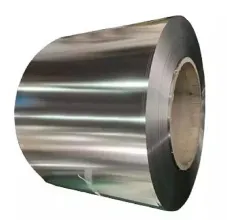
Jul . 02, 2025 11:12 Kembali ke daftar
Steel Tin Plate: A Widely Used Material
Steel Tin Plate, Also known as tinplate, it is a composite material that is coated with a layer of tin on the surface of a thin steel plate. With its excellent physical properties, good processability, and reliable corrosion resistance, Steel Tin Plate has been widely used in packaging, electronics, construction, and other fields, and has profoundly influenced the development of modern industry.

The production process of Steel Tin Plate has gone through a long development process
The early tin plating process mainly relied on manual immersion plating, which was inefficient and difficult to guarantee quality. With the advancement of technology, electroplating has gradually replaced manual immersion plating, achieving precise control of tin plating thickness and large-scale production. The production process of modern terraria tin plates usually includes substrate treatment, tin plating, passivation, painting and other steps, each of which is strictly controlled to ensure the quality of the final product.
The widespread application of Steel Tin Plate benefits from its unique advantages
Firstly, steel plates themselves have high strength and stiffness, and can withstand certain pressures and impacts. Secondly, the tin plating layer has good corrosion resistance, which can effectively prevent the steel plate from rusting and extend its service life. The inertness of tin makes it difficult to react with food, so tin cake plates are often used in packaging materials such as food cans and beverage cans to ensure the safety and hygiene of food. In addition, Steel Tin Plate has good plasticity and is easy to process through stamping, welding, etc., making it convenient to produce products of various shapes.
In the field of packaging, Steel Tin Plate is an indispensable material
From traditional food cans to modern spray cans and aerosol cans, tin candle plate has effectively protected the quality and safety of the contents with its excellent sealing, anti-corrosion and processing properties. In the field of electronics, Steel Tin Plate is often used as a casing and shielding cover for electronic components to protect them from electromagnetic interference. In the field of architecture, Steel Tin Plate can also be used for structures such as roofs and walls, providing certain waterproof and anti-corrosion protection.
Steel Tin Plate also has some limitations
The relatively high price of tin results in a higher cost for tin foil plates. In addition, Steel Tin Plate has relatively weak scratch resistance and is prone to leaving scratches. In recent years, with the continuous emergence of new materials such as aluminum alloys and plastics, the application of Steel Tin Plate in certain fields has faced certain challenges.
In summary, Steel Tin Plate, as a classic composite material, plays an important role in multiple fields with its unique advantages. Despite facing competition from other materials, Steel Tin Plate still has broad application prospects and will continue to play an important role in future industrial development by continuously improving production processes, reducing production costs, and enhancing product performance.
Steel Tin Plate FAQs
What is Steel Tin Plate?
Steel Tin Plate (commonly known as "tinplate") is a metal material that is electroplated or hot-dip tinned on the surface of low carbon steel sheets. It combines the strength of steel and the corrosion resistance of tin, and is widely used in food packaging (such as cans), chemical drums, and electronic components.
What are the main features of Steel Tin Plate?
Key features include:
Corrosion resistance: Tin layer isolates the steel substrate from air moisture and prevents rust.
Weldability: Suitable for seam welding processes in canning.
Non toxic and safe: Tin complies with food contact material standards (such as FDA).
Surface gloss: easy to print and decorate (such as beverage can patterns).
What is the difference between Steel Tin Plate and Chrome Plated Steel Plate (TFS)?
Coating material: Tin is used for Steel Tin Plate, and chromate is used for Chromium Plated Steel Plate (TFS).
Cost: TFS is cheaper, but tin has better food compatibility.
Usage: Tinplate is commonly used for food cans, while TFS is commonly used for bottle caps and chemical containers.
What are the common thicknesses and specifications of Steel Tin Plate?
Typical parameters:
Thickness: 0.15mm~0.5mm (usually around 0.2mm for food cans).
Tin plating amount: 1.1gm ²~11.2gm ² (graded and differential thickness plating).
Standard: Complies with ASTM A623 (USA) or JIS G3303 (Japan).
How to recycle Steel Tin Plate?
Recycling process:
- Classification: Separate from other metals (due to tin content, higher value).
- Smelting: High temperature separation of tin and steel, tin can be purified and reused.
- Environmental protection treatment: Tin plating is non-toxic, with a recovery rate of over 90%.
-
Reliable Water Tin Can Supplier | Durable & Sustainable Tinplate Containers
BeritaNov.24,2025
-
Reliable Water Tin Can Suppliers for Durable and Sustainable Water Storage
BeritaNov.24,2025
-
Water Tin Can Factory: Sustainable Solutions for Safe Water Packaging
BeritaNov.23,2025
-
Trusted Galvanized Malleable Iron Manufacturer for Durable Infrastructure Solutions
BeritaNov.23,2025
-
Trusted Galvanized Malleable Iron Manufacturers | Durable & Custom Iron Components
BeritaNov.22,2025
-
Galvanized Malleable Iron Factories – Durable & Cost-Effective Industrial Solutions
BeritaNov.22,2025